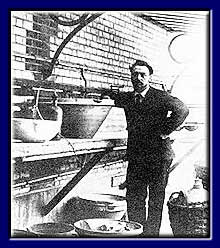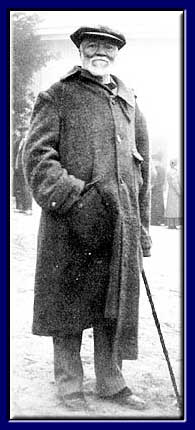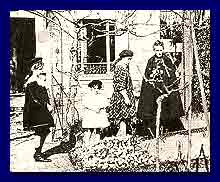The inaugural lecture
of a professor was normally an occasion for lavish tributes to one's
predecessor and eloquent claims for one's own field of science. But
the crowd heard only a matter-of-fact lecture about developments in
physics over the past decade.
“When one considers the progress
that has been made in physics in the past ten years, one
is surprised at the advance that has taken place in our
ideas concerning electricity and matter....”
--Marie Curie, opening of first Sorbonne lecture,
November 5, 1906
|
|
 |
| André Debierne, seen here
in the Curies' laboratory shed, not only helped Marie confirm
experimentally that radium was an element, but also remained a devoted
friend and colleague over the years. (Photo ACJC) |
|
During that summer,
Marie's research program-- to identify and isolate radioactive elements--intensified.
In part she was spurred on by a challenge from an unexpected quarter.
In a letter to the editor on the front page of The London Times
of August 9, 1906, Pierre's longtime fan Lord Kelvin advanced a
theory that radium was no element but rather a compound of lead
and five helium atoms. Since the theory threatened the entire science
of radioactivity, Marie began lab work to disprove it -- and more
generally to put her discovery on such a firm basis that nobody
could doubt it.
Enlisting the aid of
her old colleague André Debierne, she eventually confirmed that radium
was indeed an element. It was an effort of years to measure the atomic
weight of radium beyond question and thus firmly locate the element
in the Periodic Table. But the measurements
left nothing in doubt. |
|
 EW
PEOPLE MANAGE TO CREATE an entirely new institution from scratch,
single-handed. That is what Marie Curie set out to do--establish
a lab worthy of Pierre's memory. She had her fame, her friends,
and her fierce determination. A substantial grant in 1907 from an
American philanthropist enabled her to assemble a research staff,
but that was only a start. It helped that in the little world of
the Paris elite, the professors in Curie's circle were on good terms
with politicians in the left-leaning parties that controlled the
French government. These politicians agreed with the professors'
ideals--rational science was the vanguard of human progress. Yielding
to persuasion, the government-funded University of Paris joined
the private Pasteur Foundation to fund a Radium Institute. Marie
Curie would supervise one of its divisions, a radioactivity laboratory,
while an eminent physician would supervise the second division,
a medical research laboratory. EW
PEOPLE MANAGE TO CREATE an entirely new institution from scratch,
single-handed. That is what Marie Curie set out to do--establish
a lab worthy of Pierre's memory. She had her fame, her friends,
and her fierce determination. A substantial grant in 1907 from an
American philanthropist enabled her to assemble a research staff,
but that was only a start. It helped that in the little world of
the Paris elite, the professors in Curie's circle were on good terms
with politicians in the left-leaning parties that controlled the
French government. These politicians agreed with the professors'
ideals--rational science was the vanguard of human progress. Yielding
to persuasion, the government-funded University of Paris joined
the private Pasteur Foundation to fund a Radium Institute. Marie
Curie would supervise one of its divisions, a radioactivity laboratory,
while an eminent physician would supervise the second division,
a medical research laboratory.
“...a
laboratory is not created in a few months with a wave of a magic
wand...” --Pierre Curie in a letter to a university
administrator, 1903
|
 . . |
| American steel-manufacturer
and philanthropist Andrew Carnegie established the Curie Scholarships,
which enabled promising scientists to devote themselves full-time
to research in Marie's lab |
|
 |
| Marie in front
of the Curie home at Sceaux with her daughters and (at far left)
a friend. Irène's friendships with her classmates from the cooperative
school remained close over the years. (Photo ACJC) |
|
Her work at the Sorbonne
and in the lab was so time-consuming that Marie turned over her
position at the Sèvres school for women teachers-in-training to
her friend and colleague Paul Langevin. She nonetheless made time
to run a cooperative school with a number of other professional
parents who disapproved of the rigid French school system. Each
family agreed to teach one class each week in its field of expertise.
Between 1906 and
1908, Irène and a group of eight or nine other children were thus
privileged to learn math, science, history, literature, and studio
art from eminent figures in those fields.
|
|
 NOTHER
DEATH IN THE FAMILY deeply
saddened Marie and her daughters. Pierre's father died in February
1910. Now a series of Polish governesses, some more successful than
others, helped raise Irène and Eve. Yet during the course of that
year of mourning Marie isolated radium metal. She saw the publication
of her comprehensive textbook, A Treatise on Radioactivity.
And she secured the right to define an international standard for
radium emissions. Such a standard was essential for an efficient
radium industry and uniform medical applications. The measure she
established was accepted by the international scientific community,
which named it the Curie. NOTHER
DEATH IN THE FAMILY deeply
saddened Marie and her daughters. Pierre's father died in February
1910. Now a series of Polish governesses, some more successful than
others, helped raise Irène and Eve. Yet during the course of that
year of mourning Marie isolated radium metal. She saw the publication
of her comprehensive textbook, A Treatise on Radioactivity.
And she secured the right to define an international standard for
radium emissions. Such a standard was essential for an efficient
radium industry and uniform medical applications. The measure she
established was accepted by the international scientific community,
which named it the Curie.
“Curie.
A unit of radioactivity. One Curie is the quantity of a
radioactive substance that decays at the rate of 3.7 x 1010
disintegrations per second.”
--Dictionary definition
|
� 2000 -
American Institute of Physics
|
|

